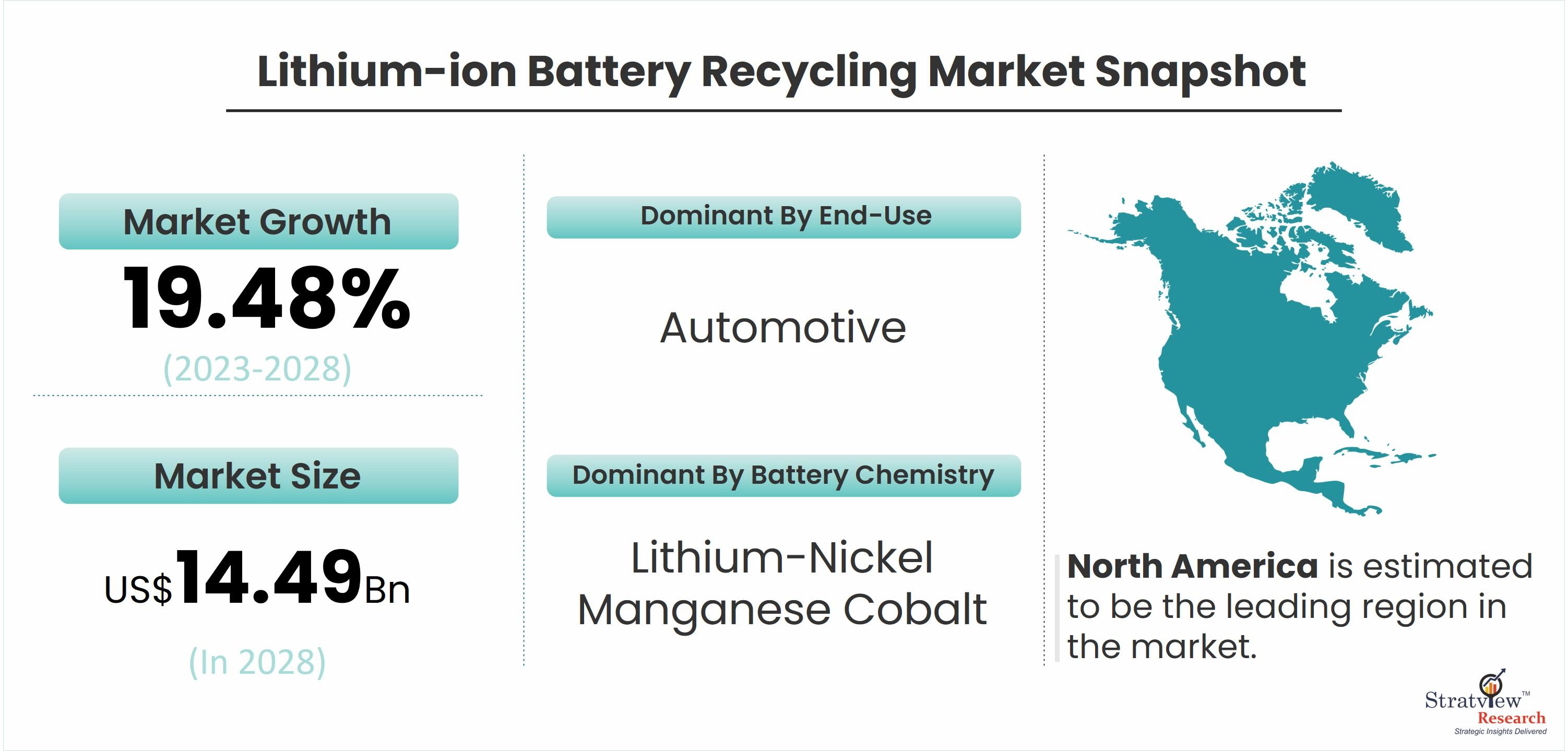Lithium-Ion Battery Recycling Market: Key Drivers of Growth in 2024

The global market for lithium-ion battery recycling is poised for substantial growth in 2024 and beyond, driven by several key factors that highlight the importance of sustainable practices in the energy and technology sectors. This article explores the primary drivers behind the growth of the lithium-ion battery recycling market and the implications for stakeholders in the industry.
According to Stratview Research, the lithium-ion battery recycling market was estimated at USD 4.96 billion in 2022 and is likely to grow at a CAGR of 19.48% during 2023-2028 to reach USD 14.49 billion in 2028.
1. Rising Demand for Electric Vehicles (EVs) and Energy Storage Systems
The increasing adoption of electric vehicles (EVs) and energy storage systems (ESS) is a major driver of the lithium-ion battery recycling market. As the automotive industry shifts towards electric mobility and renewable energy sources, the demand for lithium-ion batteries is soaring. Recycling these batteries not only helps to recover valuable materials but also mitigates environmental impacts associated with battery production and disposal.
2. Government Regulations and Environmental Policies
Stringent regulations and environmental policies aimed at reducing carbon emissions and promoting sustainable practices are accelerating the growth of the lithium-ion battery recycling market. Countries around the world are implementing recycling targets and incentivizing battery recycling initiatives to minimize the environmental footprint of lithium-ion batteries.
3. Technological Advancements in Recycling Processes
Advancements in recycling technologies are making lithium-ion battery recycling more efficient and economically viable. Innovations in hydrometallurgical and pyrometallurgical processes enable the recovery of valuable metals such as lithium, cobalt, nickel, and manganese from spent batteries. These technologies not only reduce the reliance on virgin materials but also contribute to the circular economy by closing the loop on battery materials.
4. Increasing Concerns over Resource Security
The recycling of lithium-ion batteries plays a crucial role in enhancing resource security by reducing dependence on imported raw materials. As global demand for lithium, cobalt, and other critical metals used in battery production rises, recycling offers a sustainable solution to meet future demand while minimizing geopolitical risks associated with material sourcing.
5. Growing Investment in Battery Recycling Infrastructure
Investment in battery recycling infrastructure is on the rise, driven by both public and private sectors. Governments and industry stakeholders are establishing new recycling facilities and expanding existing ones to meet the growing volume of end-of-life batteries. This infrastructure expansion is crucial for scaling up recycling capacity and improving the efficiency of battery material recovery.
6. Consumer Awareness and Corporate Sustainability Initiatives
Increased consumer awareness about the environmental impact of lithium-ion batteries and the benefits of recycling is driving demand for sustainable battery solutions. Many corporations are also integrating environmental, social, and governance (ESG) criteria into their supply chain strategies, leading to greater investment in sustainable battery technologies and recycling practices.
7. Emerging Markets for Second-Life Batteries
The emergence of second-life battery markets, where recycled batteries are repurposed for energy storage applications, is creating additional opportunities for the lithium-ion battery recycling market. Second-life batteries provide a cost-effective solution for storing renewable energy and stabilizing the grid, further driving demand for battery recycling.
Conclusion
In conclusion, the lithium-ion battery recycling market is experiencing significant growth momentum in 2024, driven by the rise in electric vehicles, stringent environmental regulations, technological advancements, and increasing investments in recycling infrastructure. As stakeholders across the industry continue to innovate and expand their recycling capabilities, the market is poised to play a pivotal role in the transition towards a sustainable and circular economy. By addressing these key drivers, the lithium-ion battery recycling market is set to contribute to environmental protection, resource security, and economic sustainability on a global scale.
- Art
- Causes
- Crafts
- Dance
- Drinks
- Film
- Fitness
- Food
- Games
- Gardening
- Health
- Home
- Literature
- Music
- Networking
- Other
- Party
- Religion
- Shopping
- Sports
- Theater
- Wellness




